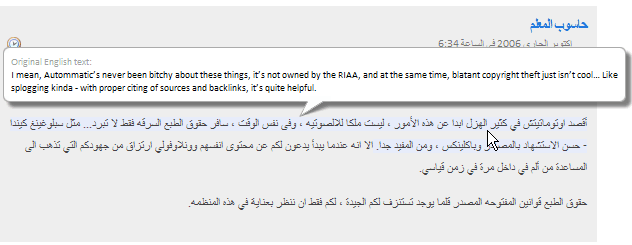Everyone’s favorite search-engine/social-networking multi-billion dollar corporation is at it again. Following the addition of several new features to the Gmail platform earlier this week, Google has also revamped certain portions of its language tools – in beta of course. It’s not available for all languages, nor is it in a place where most casual users would find it, but Google’s newest feature makes online translation of websites and documents a bit more enjoyable.
The trick is – use the Arabic. About a month ago, Google launched its brand-new (beta) English-to-Arabic and Arabic-to-English translation service, making it the first free online translation tool that actually gives decent results… of sorts. At any rate, that’s another story for another day; right now, it’s the (“Web 2.0”) technology we care about: Dynamic switching between source and destination languages on a translated webpage.
For instance, here’s our “WordPress-in-the-Name Issues” story from a couple of weeks ago in Arabic; it’s ideal because of it’s more “natural” language and glaring lack of code boxes, technospeak, and general all-around esoteric content. If you understand Arabic – ignore the grammar, it’s really bad. If you don’t, that’s ok, it doesn’t matter.
Most people have grown so used to the Google “Frame Bar” up at the top, visible when viewing cached content or translated web pages, that they never give it a second thought… until something unexpected happens. Here’s what it says this time:

Notice the “or mouse over text…” portion that isn’t available when viewing it in any other language! What does this do? Well, when you mouse over a block of text, for instance, this (badly translated) one:

becomes
That mouse-over effect is pretty damn cool. Web 2.0 aside for now (and for the rest of the article!), the practical benefits of such a dynamic translation method are quite impressive. How many times have you translated a German/Dutch/French/Spanish page that had a couple of English sentences on it to English – only to find out that already-English text was mangled along the way? Just mouse-over it!
Automated translation isn’t an exact science. Just as people make mistakes translating things, computers do too, and then some. Even Google hasn’t perfected it yet, so every little thing that makes reading or accessing machine-translated content easier certainly is an improvement. And who knows, this could be but a stepping stone. Once this reaches the other languages, it might be used to do side-by-side translations, comparisons of text in several languages, and maybe even block translation so you can translate only the things that need it!


I think, a good blend of machine translation, memory translation and consonants could bring an artificial intelligence where we can reach to a better understanding and solution of online/automated translation.